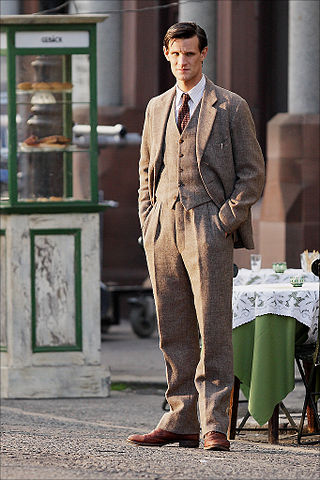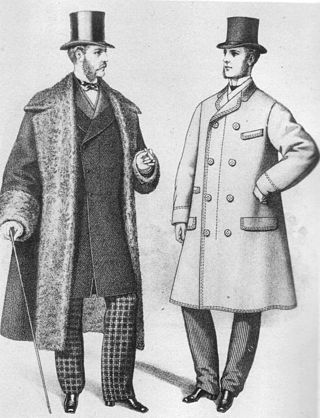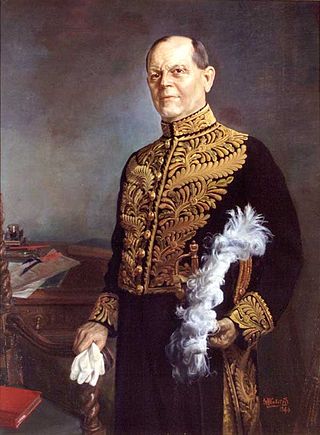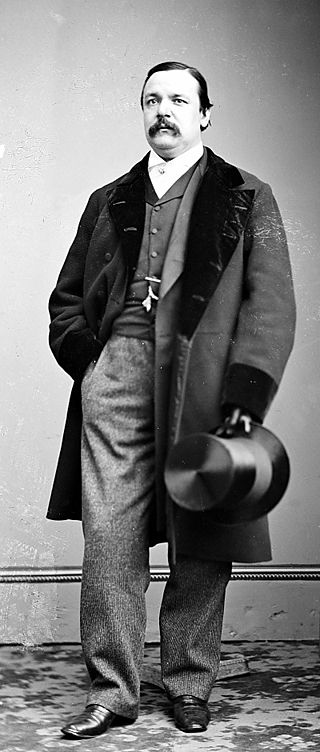Related Research Articles

Black tie is a semi-formal Western dress code for evening events, originating in British and North American conventions for attire in the 19th century. In British English, the dress code is often referred to synecdochically by its principal element for men, the dinner suit or dinner jacket. In American English, the equivalent term tuxedo is common. The dinner suit is a black, midnight blue or white two- or three-piece suit, distinguished by satin or grosgrain jacket lapels and similar stripes along the outseam of the trousers. It is worn with a white dress shirt with standing or turndown collar and link cuffs, a black bow tie, typically an evening waistcoat or a cummerbund, and black patent leather dress shoes or court pumps. Accessories may include a semi-formal homburg, bowler, or boater hat. For women, an evening gown or other fashionable evening attire may be worn.

A waistcoat or vest is a sleeveless upper-body garment. It is usually worn over a dress shirt and necktie and below a coat as a part of most men's formal wear. It is also sported as the third piece in the traditional three-piece male suit. Any given waistcoat can be simple or ornate, or for leisure or luxury. Historically, the waistcoat can be worn either in the place of, or underneath, a larger coat, dependent upon the weather, wearer, and setting.

A trench coat is a variety of coat made of waterproof heavy-duty fabric, originally developed for British Army officers before the First World War, and becoming popular while used in the trenches, hence the name trench coat.

The cassock or soutane is a Christian clerical clothing coat used by the clergy and male religious of the Oriental Orthodox Churches, Eastern Orthodox Church and the Catholic Church, in addition to some clergy in certain Protestant denominations such as Anglicans and Lutherans. "Ankle-length garment" is the literal meaning of the corresponding Latin term, vestis talaris. It is related to the habits traditionally worn by nuns, monks, and friars.

A suit, also called a lounge suit, business suit, dress suit, or formal suit is a set of clothes comprising a suit jacket and trousers of identical textiles generally worn with a collared dress shirt, necktie, and dress shoes. A skirt suit is similar, but with a matching skirt instead of trousers. It is currently considered semi-formal wear or business wear in contemporary Western dress codes, however when the suit was originally developed it was considered an informal or more casual option compared to the prevailing clothing standards of aristocrats and businessmen. The lounge suit originated in 19th-century Britain as sportswear and British country clothing, which is why it was seen as more casual than citywear at that time, with the roots of the suit coming from early modern Western Europe formal court or military clothes. After replacing the black frock coat in the early 20th century as regular daywear, a sober one-coloured suit became known as a lounge suit.
A tailcoat is a knee-length coat characterised by a rear section of the skirt, with the front of the skirt cut away.

An overcoat is a type of long coat intended to be worn as the outermost garment, which usually extends below the knee. Overcoats are most commonly used in winter when warmth is more important.

Cufflinks are items of jewelry that are used to secure the cuffs of dress shirts. Cufflinks can be manufactured from a variety of different materials, such as glass, stone, leather, metal, precious metal or combinations of these. Securing of the cufflinks is usually achieved via toggles or reverses based on the design of the front section, which can be folded into position. There are also variants with chains or a rigid, bent rear section. The front sections of the cufflinks can be decorated with gemstones, inlays, inset material or enamel and designed in two or three-dimensional forms.

A frock coat is a formal men's coat characterised by a knee-length skirt cut all around the base just above the knee, popular during the Victorian and Edwardian periods (1830s–1910s). It is a fitted, long-sleeved coat with a centre vent at the back and some features unusual in post-Victorian dress. These include the reverse collar and lapels, where the outer edge of the lapel is often cut from a separate piece of cloth from the main body and also a high degree of waist suppression around the waistcoat, where the coat's diameter round the waist is less than round the chest. This is achieved by a high horizontal waist seam with side bodies, which are extra panels of fabric above the waist used to pull in the naturally cylindrical drape. As was usual with all coats in the 19th century, shoulder padding was rare or minimal.

A dress shirt, button shirt, button-front, button-front shirt, or button-up shirt is a garment with a collar and a full-length opening at the front, which is fastened using buttons or shirt studs. A button-down or button-down shirt is a dress shirt with a button-down collar – a collar having the ends fastened to the shirt with buttons.

A cuff is a layer of fabric at the lower edge of the sleeve of a garment at the wrist, or at the ankle end of a trouser leg. The function of turned-back cuffs is to protect the cloth of the garment from fraying, and, when frayed, to allow the cuffs to be readily repaired or replaced, without changing the garment. Cuffs are made by turning back (folding) the material, or a separate band of material can be sewn on, or worn separately, attached either by buttons or studs. A cuff may display an ornamental border or have lace or some other trimming. In US usage, the word trouser cuffs refers to the folded, finished bottoms of the legs of a pair of trousers. In the UK, while this usage is now sometimes followed, the traditional term for the turned up trouser hem is 'turnup'.

Full dress uniform, also known as a ceremonial dress uniform or parade dress uniform, is the most formal type of uniforms used by military, police, fire and other public uniformed services for official parades, ceremonies, and receptions, including private ones such as marriages and funerals. Full dress uniforms typically include full-size orders and medals insignia. Styles tend to originate from 19th century uniforms, although the 20th century saw the adoption of mess dress-styled full-dress uniforms. Designs may depend on regiment or service branch. In Western dress codes, full dress uniform is a permitted supplementary alternative equivalent to the civilian white tie for evening wear or morning dress for day wear – sometimes collectively called full dress – although military uniforms are the same for day and evening wear. As such, full dress uniform is the most formal uniform, followed by the mess dress uniform.

A double-breasted garment is a coat, jacket, waistcoat, or dress with wide, overlapping front flaps which has on its front two symmetrical columns of buttons; by contrast, a single-breasted item has a narrow overlap and only one column of buttons.

Court uniform and dress were required to be worn by those in attendance at the royal court in the 19th and early 20th centuries.

An over-frock coat is a formal overcoat designed to be worn over a frock coat if needed in cold weather. A top-frock coat may also be worn over a frock coat in milder weather. Shaped like the body coats popular in the Victorian and Edwardian periods, the over-frock coat was cut in essentially the same way as the frock coat that was worn under it, although it would be larger overall to accommodate the frock-coat worn underneath. Like the frock coat, the over-frock would typically be single-breasted, with step lapels for informal occasions like business, and double-breasted with pointed lapels for formal occasions – weddings, funerals, balls, etc. The top-frock was usually double breasted. The formal variety was sometimes called a Prince Albert overcoat. The Prince Albert top frock, from the later half of the 19th century, originally had a three-inch-wide velvet collar, and flap pockets at the hip, until 1893, when it became even more fitted, longer, and double-breasted.

The following is a general overview of the Heer main uniforms, used by the German Army prior to and during World War II.
The military uniforms of the Union Army in the American Civil War were widely varied and, due to limitations on supply of wool and other materials, based on availability and cost of materials. The ideal uniform was prescribed as a dark blue coat with lighter pants, with a black hat. Officer's ranks were denoted with increasing levels of golden decoration. Specific jobs, companies, and units had markedly different styles at times, often following European customs such as that of the Zouaves. Officers uniforms tended to be highly customized and would stray from Army standard. Ironically, several main pieces of gear had been created by order of the U.S. War Secretary Jefferson Davis before the war; he later became Confederate President.

A covert coat or Crombie coat is a gentleman's overcoat typically with notched lapels which originated in the late 19th century as a "short topcoat" to be worn for hunting and horse riding.

A paletot is a type of topcoat. The name is French, but etymologically derived from the Middle English word paltok, meaning a kind of jacket.

A suit jacket, also called a lounge jacket, lounge coat or suit coat, is a jacket in classic menswear that is part of a suit.
References
- 1 2 3 "A Man's Guide to Overcoats". artofmanliness.com. December 11, 2012. Retrieved 2013-11-03.
- 1 2 Schneider, Sven Raphael (March 25, 2010). "The Guards Coat". gentlemansgazette.com. Retrieved 2013-11-03.
- ↑ "Four Favorite Overcoats". putthison.com. 17 November 2014. Retrieved 2016-11-08.